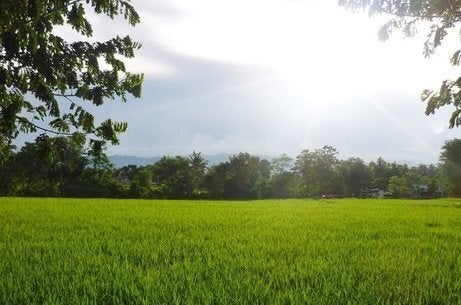
*Gregory Reeves [2014] is a Plant Sciences PhD Candidate in the Department of Plant Sciences, University of Cambridge.
The current exponential growth of human population places incredible demands on agriculture. It is estimated that agricultural production must double in order to meet projected demands by 2050. This increase must be made despite a steady loss of arable farmland, dwindling fertiliser reserves, increasing salinity of soils, limited irrigation water, climate change and shrinking of genetic variation in agronomic crops. Based on current agricultural increase, yield trends are inadequate to meet food demands by 2050.
Even now, about 870 million people are chronically undernourished. Over one billion people live on less than one pound per day and must spend over half of their income on food. Each year approximately eleven million children living in impoverishment die before reaching their fifth birthday and every day about 25,000 people die due to starvation related complications - making malnutrition one of the largest contributors to human mortality.
Inventive solutions
Meeting global food demands in the coming decades will require inventive and sustainable solutions. The scientific community agrees that one of the best ways to meet this demand for food is to enhance the ability of crops to harness energy from the sun.
Both food and biofuel production require photosynthesis to utilise abundant solar energy and store it in biomass via carbon fixation. However, photosynthesis is often limited by the availability of carbon dioxide. All plants use a photosynthetic mechanism known as C3 photosynthesis. Plants that use only C3 photosynthesis for the uptake of carbon dioxide are greatly hindered by oxygen, a waste product of photosynthesis. Interestingly, about 4% of plant species are able to overcome inhibition of oxygen and enhance their photosynthetic efficiency with a more efficient carbon fixation process, termed C4 photosynthesis, which acts as turbo charger to operate in parallel with the existing C3 pathway. In hot climates, C4 plants are more productive, drought tolerant and require less nitrogen than C3 plants.
Gene transfer
The specific objective of my research is to work towards comprehensively identifying the genes required for C4 photosynthesis with the goal to transfer them into economically important C3 crops, in particular rice and wheat which together account for about 40% of human food supply. Introducing C4 photosynthesis into these crops will potentially increase current yields by 50% while adding greater nitrogen- and water-use efficiency. If rice and wheat alone were to be converted to C4 and given the right environment, theoretically 1.4 billion more people can be fed per year without need for more farmland or agricultural inputs. This would be an incredible and sustainable solution to global food security and supply!
Transferring C4 photosynthesis into C3 crops involves alteration to leaf anatomy and partitioning the biochemical reactions encoded by existing C3 genes into different cell types, which facilitates more efficient carbon fixation. Thus, understanding how these photosynthesis genes are regulated paves a path to engineer more efficient crops for increased food and biofuel production. Transfer of C4 photosynthesis into important C3 crops could yield considerable gains by boosting world food supply at a time when agricultural production is predicted to drop beneath global demands.
